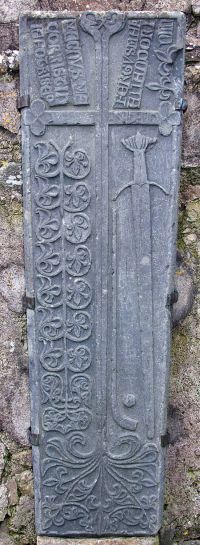
This early medieval grave stone is located in the church ruin at Clonca, close to the Bodan Cross, 3km south of Culdaff, in Inishowen, Co. Donegal. Carved from dark limestone it measures 185cm tall by 55cm wide and 14cm deep.
The Scots Gaelic inscription in Lombardic lettering reads…. “Magnus mac Orristin ia fo triat seo” (Magnus Mac Orristin of the Isles under this mound). “Fergus mac Allan do rini in clach sa” (Fergus Mac Allan made this stone).
The curved stick (known as a camán) on the slab reminds us that primitive versions of hurley were played in Ireland in ancient times, evidence of which goes back over 2000 years. Modern hurley, shinty (Scottish) and hockey have all evolved from this primitive game. In Inishowen it was a popular winter sport enjoyed by the gentry and ordinary folk particularly in post-medieval times. A cast of this unique monument is on display in the GAA Museum, Croke Park, Dublin 3.
The two-handed Scottish Claymore was commonly used by Gallóglaich, (Galloglas or Gallowglass). They were an elite class of mercenaries from the mixed Scottish-Viking population of the Hebrides and parts of western Scotland. From the mid 12th century onwards they were recruited by Irish chiefs to counteract the heavily armoured and mounted knights of the English invaders. Similarities in language and customs allowed the Galloglas to integrate easily with the locals and many settled in Ireland and inter-married. In time their ranks became filled with native Irish men. Noted for their courage and fierceness in battle they enabled the Gaelic culture to withstand the English incursion until the end of the 16th century when the introduction of muskets and cannon finally defeated them.
This Galloglas stone is strikingly similar to a collection of grave slabs found at Kilmartin Church, Argyll, Scotland. Like the Galloglas stone many feature claymores and floral motifs and they date from the same medieval period. This similarity is not surprising considering the strong connections. Many Galloglas warriors remained in Scotland through the winter months when the weather put an end to the fighting, heading back to Ireland for hire in the spring.
The Mac Sweeney clan (MacSuibhnes) transplanted completely to Ireland from their homeland around Castle Swin on the Argyll peninsula in the service of the O’Donnell’s in Donegal. The town of Milford, County Donegal, retains in its Irish name, Baile na nGallóglach, the memory of a fight between the English and the MacSuibhnes.
Other Galloglas clans of Ireland included Mac Cába (McCabe) from Aran, MacDomhnaill (MacDonald / McDonnell) from Kintyre and Islay, Mac Dubhghaill (Macdougall / McDowell from Lorne, Mac Ruairí (MacRory) from Bute, Mac Síthigh (MacSheehy / Sheehy) from Kintyre, and Mac Aodha (McCoy) from Kintyre.
For more local information on this monument go to Sean Beattie’s Article.

